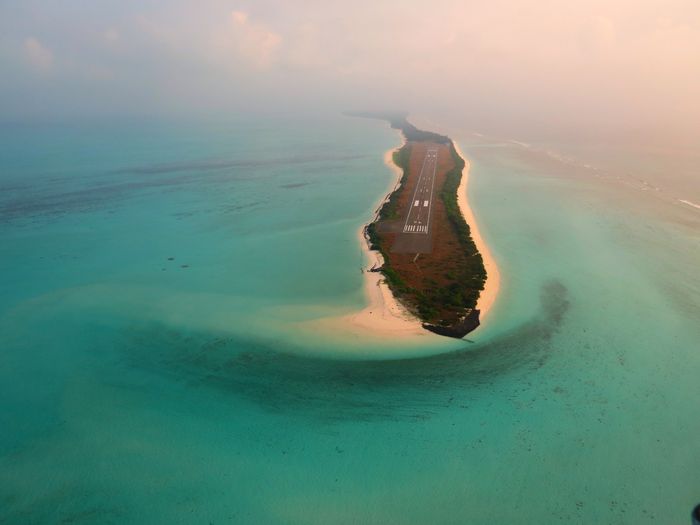Protests of inhabitants of the Lakshadweep islands against a proposed tourism project have recently made headlines in India. The protest gained support from the scientific community, warning of the severe impacts of climate change. Protecting the islands rather than exposing them to additional risk is the need of the hour.
The Lakshadweep archipelago in the Arabian Sea is a group of tiny islands – the Laccadive and Amindivi Islands and Minicoy – out of which about ten are inhabited by a total of around 65,000 people. It is the smallest Union Territory in India, 200 to 440 km off the western coast. On 31st July, 2021, the Lakshadweep Administration invited global tenders for a mega 'Maldivian Model' tourism project.
At the same time, however, the Intergovernmental Panel on Climate Change (IPCC) warns of severe impacts of climate change on India’s coastal ecosystems. They are going to face sea level rise, cyclones, increasing air and surface temperatures and changing rainfall patterns. The warming of the ocean could result in frequent and severe high tidal waves and flooding of low-lying areas.
Red flag for the near future
According to a recent study by a group of scientists from the Indian Institute of Technology (IIT), Kharagpur, sea levels will rise around Lakshadweep Islands by 0.4 to 0.9 mm per year. The worst possible inundation scenarios projected for Lakshadweep Islands are almost similar under different emission scenarios. At just two meters above sea level, all the islands in the archipelago are vulnerable and the islanders and their cultures are under threat. A population drift from outer islands will lead to rapid population growth in the main centres and lack of space for accommodation.
The Lakshadweep islands are extremely rich in marine biodiversity and have been declared as one of the 50 'hope spots' in the world by the International Union for Conservation of Nature (IUCN) that need special protection. In January 2020, 114 scientists from over 30 Indian universities and research institutes wrote to the Lakshadweep administration, asking them to abandon the colossal tourism project in view of its possible environmental impact. They say it may aggravate disasters and add more pressure on the local population already suffering from the impacts of climate change.
Whose development?
Before giving permission to such big projects, an Environment Impact Assessment (EIA) report has to be presented for public scrutiny. This has not happened yet. Despite all the concerns raised, the administration is going ahead with their plans for a public-private partnership to build 230 beach villas and 140 water villas in Suheli, Minicoy and Kadmat islands.
The already existing limited tourism in Lakshadweep is implemented by a society called SPORTS with the participation of more than 600 individual islanders as labourers, guides and water sport instructors. The Panchayat, members of SPORTS and local population have not been consulted in the planning of the new project. The project document states the role of islanders as shareholders of the business by providing land to infrastructure development. However, the per capita land ownership of the island communities is less than one hectare, governed under customary and state laws. There is a major risk that the project will lead to illegal land grab and further marginalisation of local communities.
Drinking water – a scarce resource
The IPCC has pointed out that freshwater is limited in many small islands. This also applies to Lakshadweep. Tourism is a significant water user and in conflict with the supply for residents and other economic activities. It will have a direct impact on human health and wellbeing.
The groundwater system of Lakshadweep is unique. There is sand for about half a metre below the surface, and about one metre below there is a deposit of soap stones. Between the sand and the soapstone is the sweet water lens. It is the only freshwater source available on the islands. The residents traditionally extract this water through a network of long wells that are distributed across the islands. They move from one well to another in regular intervals to avoid over extraction and salt water intrusion. Any change in this traditional practice which is not in tune with the groundwater system of the island will put the survival of local people at stake.
Save Lakshadweep
In addition to their demand for water, the proposed 5-star resorts will need to transport goods and materials from the mainland on a regular basis, which requires infrastructure. The project will have an ecological and social footprint much too large for these islands, lagoons and reefs to sustain.
Besides, given the dim prospects of the islands, such a major investment is unlikely to make business sense. Any construction there will be increasingly vulnerable to extreme weather events and rising sea levels.
Unless urgent action is taken now to reverse climate change trajectories, the majority of low-lying atolls like Lakshadweep will – according to scientific studies - become unlivable by mid-century. Lakshadweep needs urgent attention from the Government of India to devise strategies to safeguard the livelihood of the community living there. The islands need survival strategies instead of projects that will accelerate the decline.
Sumesh Mangalassery is Lead Strategic Networking, and Suma T. R. is state representative Kerala and Leads Protected Areas, Communities and Tourism. Both work at EQUATIONS (Equitable Tourism Options), a research, campaign, and advocacy organisation focussing on tourism and development issues in India.



